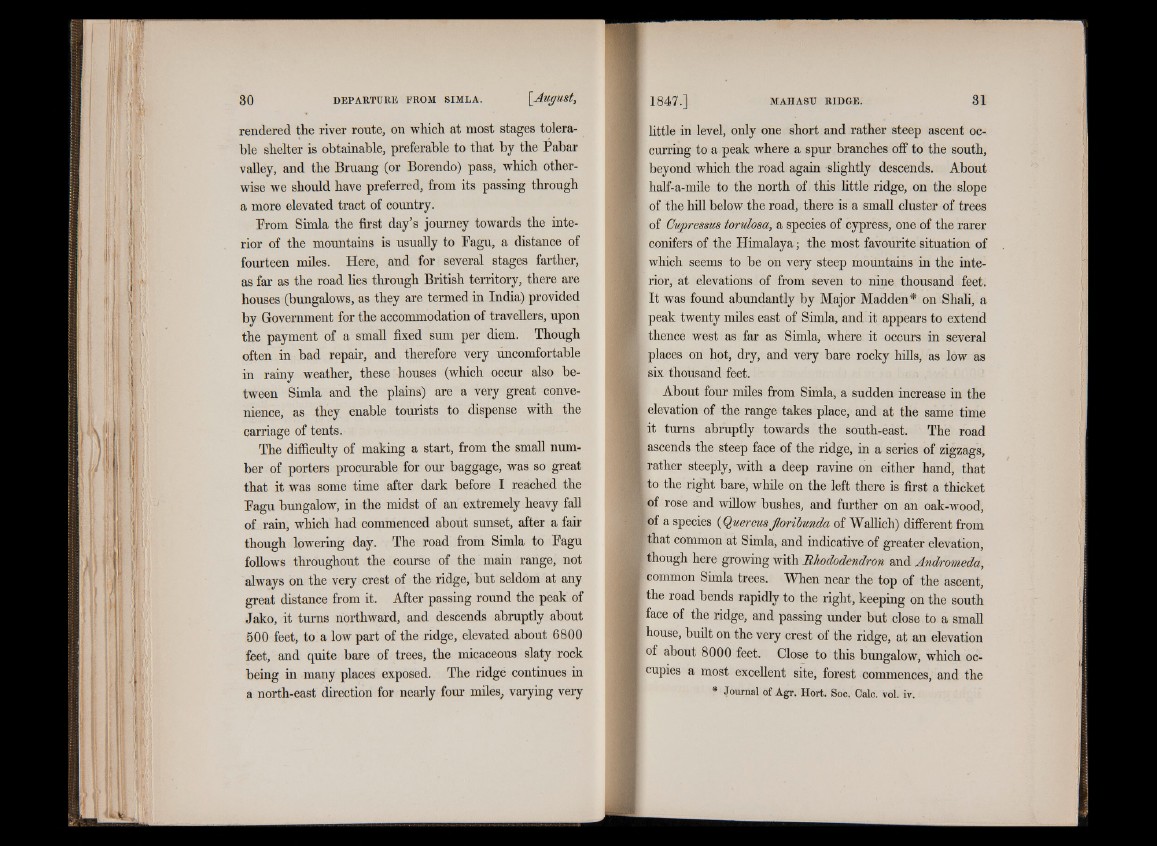
rendered the river route, on which at most stages tolerable
shelter is obtainable, preferable to that by the Pabar
valley, and the Braang (or Borendo) pass, which otherwise
we should have preferred, from its passing through
a more elevated tract of country.
Prom Simla the first day’s journey towards the interior
of the mountains is usually to Pagu, a distance of
fourteen miles. Here, and for several stages farther,
as far as the road lies through British territory, there are
houses (bungalows, as they are termed in India) provided
by Government for the accommodation of travellers, upon
the payment of a small fixed sum per diem. Though
often in bad repair, and therefore very uncomfortable
in rainy weather, these houses (which occur also between
Simla and the plains) are a very great convenience,
as they enable tourists to dispense with the
carriage of tents.
The difficulty of making a start, from the small number
of porters procurable for our baggage, was so great
that it was some time after dark before I reached the
Pagu bungalow, in the midst of an extremely heavy fall
of rain, which had commenced about sunset, after a fair
though lowering day. The road from Simla to Pagu
follows throughout the course of the main range, not
always on the very crest of the ridge, but seldom at any
great distance from it. After passing round the peak of
Jako, it turns northward, and descends abruptly about
500 feet, to a low part of the ridge, elevated about 6800
feet, and quite bare of trees, the micaceous slaty rock
being in many places exposed. The ridge continues in
a north-east direction for nearly four miles, varying very
little in level, only one short and rather steep ascent occurring
to a peak where a spur branches off to the south,
beyond which the road again slightly descends. About
half-a-mile to the north of this little ridge, on the slope
of the hill below the road, there is a small cluster of trees
of Cupressus torulosa, a species of cypress, one of the rarer
conifers of the Himalaya; the most favourite situation of
which seems to be on very steep mountains in the interior,
at elevations of from seven to nine thousand feet.
It was found abundantly by Major Madden* on Shali, a
peak twenty miles east of Simla, and it appears to extend
thence west as far as Simla, where it occurs in several
places on hot, dry, and very bare rocky hills, as low as
six thousand feet.
About four miles from Simla, a sudden increase in the
elevation of the range takes place, and at the same time
it turns abruptly towards the south-east. The road
: ascends the steep face of the ridge, in a series of zigzags,
rather steeply, with a deep ravine on either hand, that
to the right bare, while on the left there is first a thicket
of rose and willow bushes, and further on an oak-wood,
of a species (Quercus floribunda of Wallich) different from
that common at Simla, and indicative of greater elevation,
though here growing with Rhododendron and Andromeda,
common Simla trees. When near the top of the ascent,
the road bends rapidly to the right, keeping on the south
face of the ridge, and passing under but close to a small
house, built on the very crest of the ridge, at an elevation
of about 8000 feet. Close to this bungalow, which occupies
a most excellent site, forest commences, and the
* Journal of Agr. Hort. Soc. Calc. vol. iv.